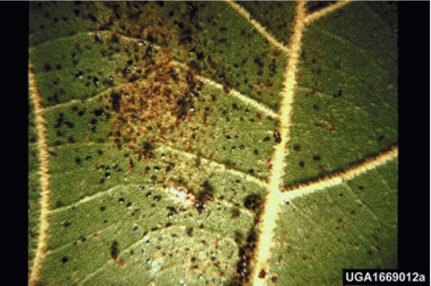PESTS AND DISEASES OF FORESTRY IN NEW ZEALAND
Something to look out for here?
Scion is the leading provider of forest-related knowledge in New Zealand
Formerly known as the Forest Research Institute, Scion has been a leader in research relating to forest health for over 50 years. The Rotorua-based Crown Research Institute continues to provide science that will protect all forests from damage caused by insect pests, pathogens and weeds. The information presented below arises from these research activities.
From Forest Health News No. 172, April 2007.
In March this year Corythucha ciliata (Tingidae), the sycamore lace bug, was found in Sydney. This is a new record for Australia.

Corythucha ciliata is native to eastern North America and was first found as an introduced species in Italy in 1964. Since then it has spread throughout much of southern and central Europe.
The usual hosts of C. ciliata are Platanus spp. (sycamores and plane trees) but in North America it has occasionally been recorded from Fraxinus (ash), Carya (hickory), and Morus (mulberry).
All life stages of the bugs occur together on the undersides of the leaves. The upper surface of infested foliage becomes marked with yellowish chlorotic spots and later with brown necrotic spots. The underside of infested leaves becomes marked with black varnish-like excrement spots, and cast skins of previous developmental stages often remain attached to infested leaves. In cases of severe infestation trees may be defoliated in late summer and damage is far more severe during dry weather. These heavy infestations are more common in urban areas than natural settings.
In Europe Corythucha ciliata is associated with two species of fungi which, in association with the lace bug, can cause decline and death of trees. It is suspected that the lace bugs may serve as vectors for these fungi. Apart from damaging trees, the lace bugs have become a major nuisance in Europe; they are particularly bothersome in open-air cafés and bars that are shaded by sycamore trees. They may also invade houses in large numbers.

Corythucha ciliata overwinter as adults, either under the loose bark of the trees, or in nearby cracks and crevices. Although delicate, the adults are very mobile and aided by wind are capable
of flying many kilometres.
There are only two members of the family Tingidae found in New Zealand. Stephanitis rhododendri has a virtually worldwide distribution and is found mainly on Rhododendron spp. It was first recorded in New Zealand in the 1950s. Tanybyrsa cumberi is found only in New Zealand. Its host is Astelia banksii.
John Bain
This information is intended for general interest only. It is not intended to be a substitute for specific specialist advice on any matter and should not be relied on for that purpose. Scion will not be liable for any direct, indirect, incidental, special, consequential or exemplary damages, loss of profits, or any other intangible losses that result from using the information provided on this site.
(Scion is the trading name of the New Zealand Forest Research Institute Limited.)



